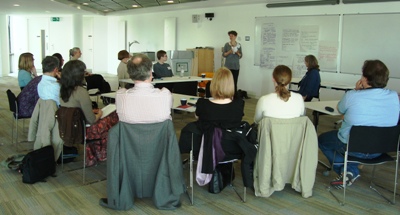Modern Materials meeting - June 10, 2011

Printable version of this text: Research Network Modern Materials Meeting
A group of 20 researchers met at the University of Glasgow on 10 June 2011 for the first of five network meetings organized by the Research Network for Textile Conservation, Dress and Textile History and Technical Art History. The theme for discussion was Modern Materials – the network’s Advisory Panel agreed at its meeting in March 2011 that this was a key area for ongoing research.
Although a succession of meetings and conferences has been held over the past 20 years to discuss the issues of collecting modern materials, the pace of collecting in both art and social history means that the challenges of preserving and interpreting contemporary artworks and artefacts remain immense.
Colleagues from overseas gave brief presentations on their work: Dr Yvonne Shashoua from the National Museum of Denmark, Dr Marco Leona of the Metropolitan Museum of Art, New York and Professor Yingin Gao of the University of Nankai in China – the University of Glasgow has just signed a memorandum of understanding with Nankai University. Other participants included curators, conservators and conservation scientists from Scotland and England as well as PhD and post-doctoral researchers.
The aim of the day was to exchange information about research already being carried out in the area of modern materials and to highlight future areas of research. It is anticipated that the day’s discussions will inform future research projects and funding applications.
The need for information exchange and communication was central to the discussions. The need to work with existing networks, such as INCCA and ICOM-CC was noted.
The following key points emerged:
- We need information on the behaviour and degradation pathways of modern materials in order to be able to make decisions about collecting, interpretation and preservation. There is a lot of information in existence already – how can this information be made more widely accessible to artists, curators, makers, the public? How can we engage with the manufacturers?
- There is a need for research to inform the gallery programme: access, collection care, conservation.
- Scientists can’t provide all the answers but need to work with curators and conservators to provide information on which decisions can be based. It’s not enough to provide identification of a material – we also need to know how it will behave and how long it will last. The importance of asking the right questions was stressed.
- There are now existing protocols for recording information when collecting contemporary artworks – the same processes could usefully be applied to social history material.
- Art schools no longer teach the behaviour of materials, with the result that artists are sometimes unable to achieve the effects they are aiming for – is the education of artists, where they would be interested in it, something conservators should get involved in? But there is a risk of changing artists’ practice.
- Collecting policies can be too materials focused, with a risk of major gaps in collections where classes of artworks or objects are deemed too risky to collect. The importance of documentation for such collections was noted, before perhaps allowing them to ‘die with dignity’.
- How do we evaluate risk? The importance of evaluating past conservation treatments was noted, with the aim of providing statistical information to inform future treatments.
- The artwork’s critical mass requires interrogation – what is the artist’s intention? The relationship between materials, concept and context is key. It was noted that traditional materials can be used in new ways in the creation of contemporary artworks, and that conservators need a different approach for such contemporary works.
- There is a need for a virtual network for information on conservation advice in Scotland, linking with international networks.
- There is a need for a group of Scottish contemporary art collectors and curators.
It is hoped that some of these topics will be addressed at the planned conference in December 2012, whose theme is also modern materials. [update as of October 2011 - we have now decided that the theme will be the same as that of our October network meeting: ‘The real thing’ and approaches to authenticity. We anticipate that this broader topic will be of interest to a range of researchers in textile conservation, dress and textile history, technical art history and related fields (including modern materials), and will stimulate some really interesting papers.]
We would like to extend sincere thanks to all the participants who contributed so much to the day’s discussions.
Frances Lennard and Erma Hermens - July 2011
